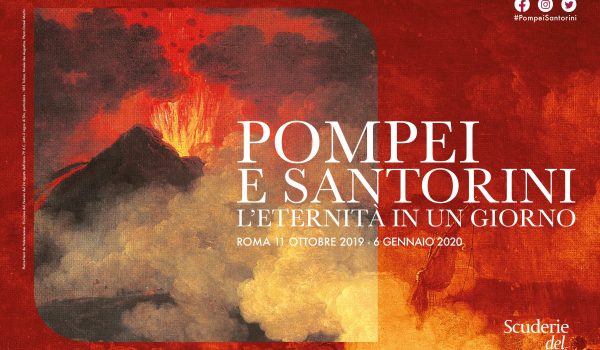Curated by Massimo Osanna, director of the Pompeii Archaeological Park, and Demetrios Athanasoulis, director of the Ephoria of Antiquities of the Cyclades, together with Luigi Gallo and Luana Toniolo, the exhibition is born out of institutional collaboration and presents an unprecedented juxtaposition through innovative reconstructions and a selection of priceless finds, many of which never previously shown to the public.
The event is conceived as a journey through time to discover the two ancient cities, which shared the same fate and were preserved for millennia by volcanic ashes.
Over 300 items, including statues, wall paintings, vases, relief panels, gems, incunabula and pictures, cover a chronological span of 3,500 years, from the Bronze Age to the present day. The tale is told as an immersive and involving experience in the rooms of the Scuderie del Quirinale, a transfigured setting for archaeological reconstructions with objects of everyday use and works of video art.
The themes explored include archaeological problems like the examination of contexts, the use of plaster casts, the analysis of social and religious customs, and the study of economic and cultural connections in the ancient Mediterranean world.
The course of the exhibition is also interspersed with works by modern and contemporary artists like Micco Spadaro, Turner, Valenciennes, Filippo Palizzi, Arturo Martini, Renato Guttuso, Andy Warhol, Alberto Burri, Richard Long, Antony Gormley, Giuseppe Penone, Francesco Jodice, Damien Hirst, James P Graham, Hans Op de Beeck and Francesco Simeti.
These works accompany visitors on their journey between the past and present, showing how much the rediscovery of the buried cities has fuelled the collective imagination. The event thus tells a story made up of sudden natural catastrophes and fascinating archaeological discoveries that shed light on the origins and development of our history and culture.
As Massimo Osanna observes, “The exhibition is the natural outcome of the institutional collaboration between the Archaeological Park of Pompeii and the Ephoria of the Cyclades. It was decided to combine the archaeological investigations with geological examination of the volcanic events so as to make visitors aware of how unique the state of preservation of the two cities really is. Equal importance attaches to the inclusion of certain works of modern and contemporary art chosen on the basis of their evocative power.”
As Demetrios Athanasoulis explains, “The Ephoria of the Cyclades has decided to implement an outward-looking policy of exhibitions both in Greece and in other countries aimed at increasing awareness of the region’s monumental heritage and of making antiquity a source not only of culture and knowledge but also of high-quality entertainment and pleasure. The event at the Scuderie del Quirinale is an expression of this vision. By presenting materials from the prehistoric city of Akrotiri outside Greece for the first time ever, it will enable the general public to know the true face of the “Pompeii” of the ancient Aegean.
Special events and workshops will help to cast richer and deeper light on the content of an exhibition of extraordinary breadth. Groups of school children will be offered real experience of the archaeologist’s work, for example, through activities involving them in the identification of finds from an excavation. Older visitors can instead embark on a literary tour accompanied by the words of writers and philosophers from antiquity to the 20th century. In addition to the workshops and meetings hosted inside the Scuderie del Quirinale, there will be a series of events at the Teatro Argentina in Rome with archaeologists, art historians, intellectuals and journalists to examine volcanic phenomena in scientific, geological and social terms as well as offering a sort of virtual walk through the rooms of the exhibition.
Mario De Simoni, President of the Scuderie del Quirinale, sums it all up in these words, “This is an exhibition fully in line with our tradition of international relations at the highest level and organic links with the major Italian cultural institutions, in this case the Archaeological Park of Pompeii. As in all the activities that have distinguished the Scuderie del Quirinale from the very outset, specific educational workshops have again been developed for different age groups, starting with children at the age of three, as well as a rich programme of lectures and meetings with scholars and experts of international standing.”
All of the information on workshops for schools and families, guided visits and meetings with the public is available from www.scuderiequirinale.it.


